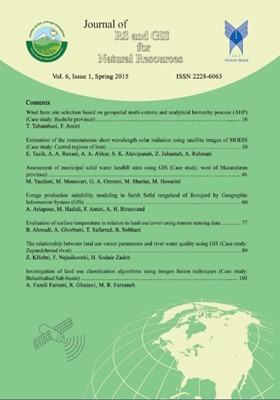-
-
List of Articles
-
Open Access Article
1 - Wind farm site selection based on geospatial multi-criteria and analytical hierarchy process (AHP) (Case study: Bushehr province)
Tayebeh Tabatabaei Fazel Amiri -
Open Access Article
2 - Estimation of the instantaneous short wavelength solar radiation using satellite images of MODIS (Case study: Central regions of Iran)
Esmaeil Tazik Abdol Ali Rezaei Ali Abkar Seyed Kazem Alavipanah Zahra Jahantab Alireza Rahmati -
Open Access Article
3 - Assessment of municipal solid waste landfill sites using GIS (Case study: west of Mazandaran province)
Mohadese Yazdani Seyed Masoud Monavari Ghasem Ali Omrani Mahmoud Shariat Seyed Mohsen Hosseini -
Open Access Article
4 - Forage production suitability modeling in Sarab Sefid rangeland of Borujerd by Geographic Information System (GIS)
Ali Ariapour Moslem Hadidi Fazel Amiri Ali Hossein Biranvand -
Open Access Article
5 - Evaluation of surface temperature in relation to land use/cover using remote sensing data
Behrouz Ahmadi Ardavan Ghorbani Taher Safarrad Behrouz Sobhani -
Open Access Article
6 - The relationship between land use vector parameters and river water quality using GIS (Case study: Zayandehrood river)
Zahra Khebri Farhad Nejadkoorki Hamid Sodaie Zadeh -
Open Access Article
7 - Investigation of land use classification algorithms using images fusion techniques (Case study: Beheshtabad Sub-basin)
Arash Fazeli Farsani Reza Ghazavi Mohammad Reza Farzaneh
-
The rights to this website are owned by the Raimag Press Management System.
Copyright © 2021-2025







